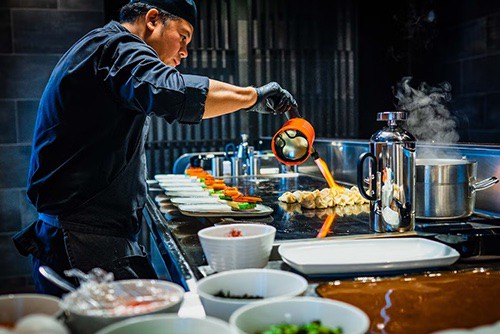7 Effective Code Of Conduct Examples
A professional code of conduct is a key component of some of the most successful...

Want to improve what your team members do, what they say, how they behave, and how they treat others (coworkers and customers alike)? Build a strong restaurant culture.
In this article, the management experts at Sling show you how to enhance your restaurant culture in order to bring your employees together as a team and make your business run smoother.

In order to understand restaurant culture, you first need to step back and look at the broad definition of company culture (a.k.a. organizational culture).
That general, textbook definition is:
The behavior within an organization and the meaning that people attach to that behavior.
As a tool for understanding, that concept is rather vague. But when you zoom in and identify the fundamental factors that contribute to the behavior within an organization, the whole idea begins to make more sense.
Those fundamental factors include:
When you understand that these aspects of your business influence the culture therein, you can begin to implement small improvements — to vision, values, language, habits, etc. — that send ripples throughout your company.

Restaurant culture matters because it’s the “everyday life” of your team and your business as a whole.
From your employees’ point-of-view, restaurant culture is the atmosphere and dynamic they experience with their coworkers, supervisors, and managers.
When your employees feel comfortable within your restaurant culture, they are more likely to enjoy their time at work, develop better relationships, and be more productive.
If, on the other hand, your employees don’t feel comfortable within your restaurant culture, they are far less likely to enjoy their time at work. As a result, their relationships and productivity will suffer.
Restaurant culture even affects your customers. The behaviors your team members exhibit grow directly from whether they’re happy with the culture or not.
A disgruntled employee can unknowingly poison the customer experience and drive satisfaction down. That, then, affects your bottom line and the success of your business.

The concept of ethics in your business is one of the least visible components of your restaurant culture. But, when done right, ethics have far-reaching effects that manifest in every corner of your company.
Ethics include such behaviors as:
When you emphasize ethics as an underlying principle, you have a profound impact on your restaurant culture by improving the way your team members act toward each other and your customers.
For a more in-depth examination of how ethics influence restaurant culture, take a moment to read our article Transform Your Business Culture With Ethics In The Workplace.
A vision statement is a declaration of an organization’s objectives intended to guide internal decision-making. A mission statement is a short description of what your company does for its customers, its employees, and its owners.
As you can see from the definitions, a mission statement and a vision statement are closely related. So much so that many managers confuse the two.
To help dispel the confusion, think about the two in terms of who, what, why, and where.
The vision statement is the where of your business — where you want the company to be and where you want your customers, your community, and your world to be as a result of your product or service.
The mission statement, then, is the who, what, and why of your business. Think of the mission statement as a roadmap or action plan that guides you in making the vision statement a reality.
When you fully refine your vision and mission statements, they inform your team members as to what your business is all about. This information guides them in their behavior and lays the foundation for a strong restaurant culture.
Organizational strategy is a plan that specifies how your business will allocate resources (e.g., money, labor, and inventory) to support infrastructure, production, marketing, inventory, and other business activities.
When you sit down to create your organizational strategy, you should first divide it into three distinct categories:
Think of each category as a building block in the larger organizational strategy that guides your business.
With these strategies in place, you give your business direction and priorities, which then influence culture.
Your employee handbook is a resource that tells team members what you expect from them and what they can expect from you.
Adding a section that defines your company’s culture is an effective way to state directly a business aspect that often goes unspoken.
For help creating and perfecting your employee handbook, check out our article 11 Tips For Making A Restaurant Employee Handbook.

Whether you’re creating a restaurant culture from scratch or trying to improve an existing culture, building a sense of purpose for your team can go a long way toward making either of those goals a reality.
To help find the right purpose (that leads to a strong culture), back up a step and try to identify what or whom your business serves. In essence, you want to understand the “why” of your operation.
Once you’ve done that, you can design a purpose that will give your team the direction and drive that leads to a strong culture.
In order for your restaurant culture to be successful, everyone must operate under the same set of values and standards. But how will they know what those values and standards are unless they see them in black and white?
Take the time to define the principles that underlie the restaurant culture you want to achieve and include them in your employee handbook.
This may feel similar to a step we discussed earlier (Define culture in your employee handbook), but it’s just different enough that it bears inclusion.
Think of defining culture as the overarching strategy you want to achieve, while defining the values and standards is more akin to the specific steps you’re going to take to fulfill said strategy.
Once you’ve built a sense of purpose and defined your culture as a whole — including the specific values and standards that support it — you’re ready to create a code of conduct.
A code of conduct is a set of rules that guides behavior in your business and provides a framework for ethical decision-making within your business.
As such, your code of conduct may include items such as:
This may seem like a lot at first, but as your organization grows, each of these points can help improve and strengthen your company culture.
That said, don’t feel like you have to sit down and hammer these all out in one sitting. Start with one or two and work slowly through the rest until you have everything you need.

If you want your team to support the culture you’re trying to build, you must lead by example and support the culture yourself.
The most effective leaders don’t just talk about the business’s values and standards, they embody the values and standards they want to see in their team.
If you’re having trouble motivating your team to accept the restaurant culture you’re trying to create, take a step back and analyze your own activities to see if there’s any way you can bring them more in line with the code of conduct you’ve already established.
Honesty is one of the cornerstones of a strong and productive business culture. Always strive to tell the truth — and ask for the truth from the members of your team as well.
Make it a point to tell your employees what they need to hear, not just what they want to hear.
If your staff did a good job but a specific component could have been better, tell them. Don’t just placate them with meaningless platitudes and move on. Be honest, call them out, and push them to find ways to improve the next time around.
But, remember, honesty needs to go both ways. That means encouraging your team members to be honest with you and with each other.
When those around you feel safe to be honest, trust may increase, and your business can function better.
If you think of strong company culture as a skyscraper, one of the pillars that supports the entire edifice is communication.
Effective communication — be it between managers and their direct reports or between team members themselves — is all about adjusting what and how you say it so that the recipient of the message understands things with as little difficulty as possible.
Making your team communication as effective as possible (e.g., clear and concise) can help support the culture you’re trying to build and can dramatically improve the way your team and your business operate in the process.
Just like other aspects of your business, your restaurant culture is a living, breathing thing that may change over time. At least once a year, assess the culture to see if it’s changed. If it has, are the changes good or bad?
If the former, consider making them a permanent part of your code of conduct. If the latter, take steps to get things back on the right track as quickly as possible.

Building a strong restaurant culture is just like any other business objective — you have to know where you want to go before you can get there.
Just saying to yourself, “I want to improve company culture,” does very little to make it a reality. Be as specific as possible about what you want to do, and the direction may present itself.
To that end, set goals for where you want to see the culture in one month, three months, six months, or a year, and then find the techniques from this list that help you achieve those goals.
Sometimes, the company culture you’re trying to create — or the way you’re going about it — is at cross purposes with the dominant personality traits of those on your team.
With a bit of time and effort, though, you can identify the different types of employees you’ve got on your team. Armed with that knowledge, you can then find ways to build a strong culture that are more conducive to the ways your employees normally think and act.
Keep in mind, though, that the purpose of all of this isn’t to discriminate. The purpose is to find ways to operate that are more of a fit for their personality types.
When you can do that, your team will be more motivated — and, likely, find it easier — to act according to the culture you have in mind for your business.
Hiring a diverse team can have a positive effect on your company culture because it brings more unique perspectives into the mix.
When you build your company culture with diversity in mind, you can harness the power of those perspectives for the betterment of everyone involved.
A diverse team can also help reduce negative emotions, like racism, sexism, ageism, and homophobia, that can infect your company culture and cause serious problems.
And, while many of the tips on this list are focused on the internal aspects of your business, creating a diverse team can also have a positive effect on some external aspects of your business, including:
These aspects, and others, then form a feedback loop of sorts that serves to strengthen your company culture from the outside while you work to strengthen it from the inside.
While you work hard to assemble a diverse team — one that is comprised of a group of people who exhibit unique and novel personality traits and characteristics — inclusivity functions to bring everyone together under a common culture.
More specifically, inclusivity refers to the standards and behaviors within your team (and your business) that ensure that every employee:
In simpler terms, workplace inclusivity stresses the fact that the thoughts, ideas, and perspectives of all individuals matter and that your business considers every point of view before it makes a decision.
When everyone on your team feels like you hear and appreciate their unique perspective, they’ll be more likely to get involved, abide by the company culture, and give their all at whatever you ask them to do.

If you want to create a positive culture in your restaurant, use Sling to create the perfect work schedule for your team.
Sling simplifies and streamlines every aspect of the scheduling process — from who works when, where, and in what job to labor expenses, payroll, and overtime — giving you more time (and energy) to focus on building and maintaining a happy, healthy, and productive culture.
Not only is Sling an extremely powerful and versatile scheduling app, but it’s also a mobile time clock, labor-cost analyzer, intra-business messaging system, newsfeed manager, and employee task list all rolled into one easy-to-use package.
You can even use one Sling account to schedule employees across multiple locations. Add in the onboard A.I. that notifies you when there’s a scheduling conflict or you missed a request for time off, and you’ve got the perfect system for managing your team.
And when you’re happy with the schedule and your team members are happy with the schedule, it’s much easier to maintain a strong restaurant culture.
The Sling app is free, easy to use, and will help you spend your time more efficiently so you can concentrate on building the intangible aspects of your team — like company culture, your management style, and your business as a whole.
For more free resources to help you manage your business better, organize and schedule your team, and track and calculate labor costs, visit GetSling.com today.
See Here For Last Updated Dates: Link
This content is for informational purposes and is not intended as legal, tax, HR or any other professional advice. Please contact an attorney or other professional for specific advice.
Schedule faster, communicate better, get things done.